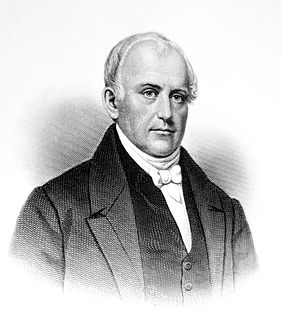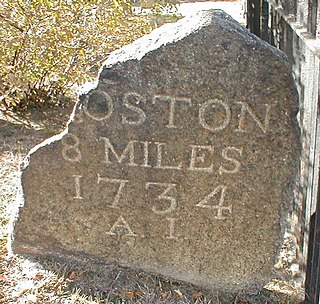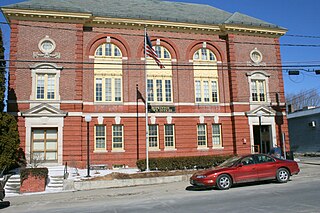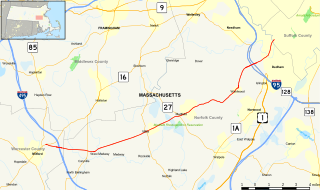
in Massachusetts
The Central Turnpike was a private toll road in Massachusetts that was chartered by the Massachusetts State Legislature on June 12, 1824. [1] The route began in Wellesley (at the time known as West Needham), heading west to Dudley, where it continued into Connecticut as the Center Turnpike.

In the late 18th century and early 19th century, turnpikes, as opposed to ordinary roads of the same time, were roads where gates barred travelers from continuing and at which payments were demanded for the use of the road. The word "turnpike" itself comes from the fact that these gates, called "pikes," were "turned" once the toll was paid. The privilege of building and operating turnpikes was conferred by the state legislature to "turnpike corporations". Turnpikes were constructed using private capital, were privately owned, and were operated for revenue from toll collection. The turnpike era in Massachusetts began in 1796, when the first act of incorporation for a turnpike was passed. By 1850, most turnpike corporations had either been dissolved or had stopped collecting tolls. In all, 118 acts of incorporation were passed. Typical toll rates were twenty-five cents for every coach with additional charges of four cents for every man and horse.

Massachusetts, officially the Commonwealth of Massachusetts, is the most populous state in the New England region of the northeastern United States. It borders on the Atlantic Ocean to the east, the states of Connecticut and Rhode Island to the south, New Hampshire and Vermont to the north, and New York to the west. The state is named after the Massachusett tribe, which once inhabited the east side of the area, and is one of the original thirteen states. The capital of Massachusetts is Boston, which is also the most populous city in New England. Over 80% of Massachusetts's population lives in the Greater Boston metropolitan area, a region influential upon American history, academia, and industry. Originally dependent on agriculture, fishing and trade, Massachusetts was transformed into a manufacturing center during the Industrial Revolution. During the 20th century, Massachusetts's economy shifted from manufacturing to services. Modern Massachusetts is a global leader in biotechnology, engineering, higher education, finance, and maritime trade.

Wellesley is a town in Norfolk County, Massachusetts, United States. Wellesley is part of Greater Boston. The population was 27,982 at the time of the 2010 census. In 2008, Wellesley had the 3rd highest median household and family incomes in all of Massachusetts. In 2018, data from the American Community Survey revealed that Wellesley was the 7th wealthiest city in the United States. It is best known as the home of Wellesley College, Babson College, and a campus of Massachusetts Bay Community College.
The corporation was headed by Samuel Slater, Joseph Valentine, and John J. Clark. It was not completed until 1830, and was in revenue service for less than six years as a whole. In January 1836, the corporation ceded the entirety of its length in Middlesex County to the state, and made the remainder toll-free by 1839 when the corporation dissolved. The Connecticut portion of the turnpike, run as a separate corporation chartered in Connecticut, continued in service until 1853. [2]

Samuel Slater was an early English-American industrialist known as the "Father of the American Industrial Revolution" and the "Father of the American Factory System". In the UK, he was called "Slater the Traitor" because he brought British textile technology to America, modifying it for United States use. He memorized the designs of textile factory machinery as an apprentice to a pioneer in the British industry before migrating to the United States at the age of 21. He designed the first textile mills in the US and later went into business for himself, developing a family business with his sons. A wealthy man, he eventually owned thirteen spinning mills and had developed tenant farms and company towns around his textile mills, such as Slatersville, Rhode Island.

Middlesex County is a county in the Commonwealth of Massachusetts, in the United States. As of 2016, the estimated population was 1,589,774, making it the twenty-first most populous county in the United States, and the most populous county in both Massachusetts and New England. As part of the 2010 national census, the Commonwealth's mean center of population for that year was geo-centered in Middlesex County, in the town of Natick at. Middlesex County is included in the Census Bureau’s Boston–Cambridge–Newton, MA–NH Metropolitan Statistical Area.
Today, the route is still mostly in use as various public roads, only a short unimproved section between Northbridge and Upton is not in use today.

Northbridge is a town in Worcester County, Massachusetts, United States. The population was 15,707 at the 2010 census. The Northbridge Town Hall is located at 7 Main Street in Whitinsville. The town is now a part of the Blackstone River Valley National Heritage Corridor, of the National Park Service. Northbridge claims to history include: Native American Nipmuc lands, Colonel John Spring, who led the Uxbridge militia training company in the American Revolution, Samuel Spring, Revolutionary War Chaplain, the Residence of Ezra T. Benson 1830-1832, the birthplace of President Millard Fillmore's mother, Phoebe, and home to the Whitin Machine Works from 1831 to 1964

Upton is a town in Worcester County, Massachusetts, United States. It was first settled in 1728. The population was 7,542 at the 2010 census, with over 2,100 households.

















